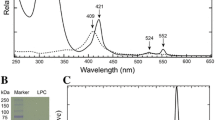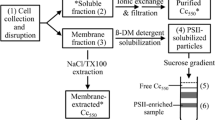Abstract
Cytochrome c z is found in green sulfur photosynthetic bacteria, and is considered to be the only electron donor to the special pair P840 of the reaction center. It consists of an N-terminal transmembrane domain and a C-terminal soluble domain that binds a single heme group. Large scale expression of the C-terminal functional domain of the cytochrome c z (C-cyt c z) from the thermophilic bacterium Chlorobium tepidum has been achieved using the Escherichia coli expression system. The C-cyt c z expressed has been highly purified, and is stable at room temperature over 10 days of incubation for both reduced and oxidized forms. Spectroscopic measurements indicate that the heme iron in C-cyt c z is in a low-spin state and this does not change with the redox state. 1H-NMR spectra of the oxidized C-cyt c z exhibited unusually large paramagnetic chemical shifts for the heme methyl protons in comparison with those of other Class I ferric cytochromes c. Differences in the 1H-NMR linewidth were observed for some resonances, indicating different dynamic environments for these protons. Crystals of the oxidized C-cyt c z were obtained using ammonium sulfate as a precipitant. The crystals diffracted X-rays to a maximum resolution of 1.2 Å, and the diffraction data were collected to 1.3 Å resolution.






Similar content being viewed by others
Abbreviations
- C-cyt c z :
-
C-terminal domain of the cytochrome c z
- Chl :
-
Chlorobium
- CD:
-
Circular dichroism
- MALDI–TOF:
-
Matrix-assisted laser desorption/ionization time-of-flight
- MCD:
-
Magnetic circular dichroism
- PCR:
-
Polymerase chain reaction
- PEG:
-
Polyethylene glycol
- RC:
-
Reaction center
- RR:
-
Resonance Raman
References
Arslan E, Schulz H, Zufferey R, Künzler P, Thöny-Meyer L (1998) Overproduction of the Bradyrhizobium japonicum c-type cytochrome subunits of the cbb 3 oxidase in Escherichia coli. Biochem Biophys Res Commun 251:744–747
Banci L, Bertini I, Cambria MT, Capozzi F, Dikiy A (1994) 1H one-dimensional and two-dimensional NMR studies of the ferricytochrome c 551 from Rhodocyclus gelatinosus. Eur J Biochem 219:663–669
Blauer G, Screerama N, Woody RW (1993) Optical activity of hemoproteins in the Soret region. Circular dichroism of the heme undecapeptide of cytochrome c in aqueous solution. Biochemistry 32:6674–6679
Desbois A (1994) Resonance Raman spectroscopy of c-type cytochromes. Biochimie 76:693–707
Fee JA, Chen Y, Todaro TR, Bren KL, Patel KM, Hill MG, Gomez-Moran E, Loehr TM, Ai J, Thöny-Meyer L, Williams PA, Stura E, Sridhar V, McRee DE (2000) Integrity of Thermus thermophilus cytochrome c 552 synthesized by Escherichia coli expressing the host-specific cytochrome c maturation genes, ccmABCDEFGH: biological, spectral, and structural characterization of the recombinant protein. Protein Sci 9:2074–2084
Feiler U, Hauska G (1995) The reaction center from green sulfur bacteria. In: Blankenship RE, Madigan MT, Bauer CD (eds) Anoxygenic photosynthetic bacteria. Kluwer, Dordrecht, pp 665–685
Hauska G, Schoedle T, Remigy H, Tsiotis G (2001) The reaction center of green sulfur bacteria. Biochim Biophys Acta 1507:260–277
Hirano Y, Higuchi M, Azai C, Oh-oka H, Miki K, Wang Z-Y (2009) Crystal structure of the electron carrier domain of the reaction center cytochrome c z subunit from green photosynthetic bacterial Chlorobium tepidum (to be submitted)
Hsu M-C, Woody RW (1971) The origin of the heme Cotton effects in myoglobin and hemoglobin. J Am Chem Soc 93:3515–3525
Hu S, Morris IK, Singh JP, Smith KM, Spiro TG (1993) Complete assignment of cytochrome c resonance Raman spectra via enzymic reconstitution with isotopically labeled hemes. J Am Chem Soc 115:12446–12458
Hurt EC, Hauska G (1984) Purification of membrane-bound cytochromes and a photoactive P840 protein complex of the green sulfur bacterium Chlorobium limicola f. thiosulfatophilum. FEBS Lett 168:149–154
Jenney FE, Prince RC, Daldal F (1994) Roles of the soluble cytochrome c2 and membrane-associated cytochrome cy of Rhodobacter capsulatus in photosynthetic electron transfer. Biochemistry 33:2496–2502
Judd RC (2002) SDS-polyacrylamide gel electrophoresis of peptides. In: Walker JM (ed) The protein protocols handbook, 2nd edn. Humana Press, Totowa, pp 73–79
Kitagawa T, Kyogoku Y, Iizuka T, Ikeda-Saito M, Yamanaka T (1975) Resonance Raman scattering from hemoproteins. J Biochem 78:719–728
Kusumoto N, Sétif P, Brettel K, Seo D, Sakurai H (1999) Electron transfer kinetics in purified reaction centers from the green sulfur bacterium Chlorobium tepidum studied by multiple-flash excitation. Biochemistry 38:12124–12137
Lanir A, Yu N-T, Felton RH (1979) Conformational transitions and vibronic couplings in acid ferricytochrome c: a resonance Raman study. Biochemistry 18:1656–1660
Lee D-W, Öztürk Y, Osyczka A, Cooley JW, Daldal F (2008) Cytochrome bc 1-c y fusion complexes reveal the distance constraints for functional electron transfer between photosynthesis components. J Biol Chem 283:13973–13982
Meyer TE (1996) Evolution and classification of c-type cytochromes. In: Scott RA, Mauk AG (eds) Cytochrome c: a multidisciplinary approach. University Science Books, Sausalito, pp 33–99
Miroux B, Walker JE (1996) Over-production of proteins in Escherichia coli: mutant hosts that allow synthesis of some membrane proteins and globular proteins at high levels. J Mol Biol 260:289–298
Myer YP (1968) Conformation of cytochromes. J Biol Chem 243:2115–2122
Oh-oka H (2007) Type 1 reaction center of photosynthetic heliobacteria. Photochem Photobiol 83:177–186
Oh-oka H, Kamei S, Matsubara H, Iwaki M, Itoh S (1995) Two molecules of cytochrome c function as the electron donors to P840 in the reaction center complex isolated from a green sulfur bacterium, Chlorobium tepidum. FEBS Lett 365:30–34
Oh-oka H, Iwaki M, Itoh S (1997) Viscosity dependence of the electron transfer rate from bound cytochrome c to P840 in the photosynthetic reaction center of the green sulfur bacterium Chlorobium tepidum. Biochemistry 36:9267–9272
Oh-oka H, Iwaki M, Itoh S (1998) Membrane-bound cytochrome c z couples quinol oxidoreductase to the P840 reaction center complex in isolated membranes of the green sulfur bacterium Chlorobium tepidum. Biochemistry 37:12293–12300
Oh-oka H, Iwaki M, Itoh S (2002) Electron donation from membrane-bound cytochrome c to the photosynthetic reaction center in whole cells and isolated membranes of Heliobacterium gestii. Photosynth Res 71:137–147
Okkels JS, Kjær B, Hansson Ö, Svendsen I, Møller BL, Scheller HV (1992) A membrane-bound monoheme cytochrome c 551 of a novel type is the immediate electron donor to P840 of the Chlorobium vibrioforme photosynthetic reaction center complex. J Biol Chem 267:21139–21145
Okumura N, Shimada K, Matsuura K (1994) Photo-oxidation of membrane-bound and soluble cytochrome c in the green sulfur bacterium Chlorobium tepidum. Photosynth Res 41:125–134
Onodera S, Suzuki H, Shimada Y, Kobayashi M, Nozawa T, Wang Z-Y (2007) Overexpression and characterization of the Rhodobacter sphaeroides PufX membrane protein in Escherichia coli. Photochem Photobiol 83:139–144
Ookubo S, Nozawa T, Hatano M (1987) Iron(II) and iron(III) low and high spin complexes formed from p-nitrophenolatoiron(III) complex of protoporphyrin-IX-dimethylester in the presence of 1-methylimidazole: magnetic circular dichroism and 1H nuclear magnetic resonance spectroscopic studies. J Inorg Biochem 30:45–68
Othman S, Le Lirzin A, Desbois A (1994) Resonance Raman investigation of imidazole and imidazolate complexes of microperoxidase: characterization of the bis(histidine) axial ligation in c-type cytochromes. Biochemistry 33:15437–15448
Otwinowski Z, Minor W (1997) Processing of X-ray diffraction data collected in oscillation mode. In: Charles W, Carter J, Robert MS (eds) Methods in enzymology macromolecular crystallography part A, vol 276. Academic Press, New York, pp 307–326
Pielak GJ, Auld DS, Betz SF, Hilgen-Willis SE, Garcia LL (1996) Nuclear magnetic resonance studies of Class I cytochromes c. In: Scott RA, Mauk AG (eds) Cytochrome c: a multidisciplinary approach. University Science Books, Sausalito, pp 203–284
Senn H, Wüthrich K (1983) Conformation of the axially bound ligands of the heme iron and electronic structure of heme c in the cytochromes c-551 from Pseudomonas mendocina and Pseudomonas stutzeri and cytochrome c 2 from Rhodospirillum rubrum. Biochim Biophys Acta 746:48–60
Senn H, Keller RM, Wüthrich K (1980) Different chirality of the axial methionine in homologous cytochrome c determined by 1H NMR and CD spectroscopy. Biochem Biophys Res Commun 92:1362–1369
Shokhirev NV, Walker FA (1998) The effect of axial ligand plane orientation on the contact and pseudocontact shifts of low-spin ferriheme proteins. J Biol Inorg Chem 3:581–594
Spaulding LD, Chang CC, Yu N-T, Felton RH (1975) Resonance Raman spectra of metallooctanaethylporphyrins. Structural probe of metal displacement. J Am Chem Soc 97:2517–2525
Spiro TG, Burke JM (1976) Protein control of porphyrin conformation. Comparison of resonance Raman spectra of heme proteins with mesoporphyrin IX analogues. J Am Chem Soc 98:5482–5489
Spiro TG, Strekas TC (1974) Resonance Raman spectra of heme proteins. Effects of oxidation and spin state. J Am Chem Soc 96:338–345
Spiro TG, Stong JD, Stein P (1979) Porphyrin core expansion and doming in heme proteins. New evidence from resonance Raman spectra of six-coordinate high-spin ion(III) hemes. J Am Chem Soc 101:2648–2655
Suzuki H, Hirano Y, Kimura Y, Takaichi S, Kobayashi M, Miki K, Wang Z-Y (2007) Purification, characterization and crystallization of the core complex from thermophilic purple sulfur bacterium Thermochromatium tepidum. Biochim Biophys Acta 1767:1057–1063
Thomas PE, Ryan D, Levin W (1976) An improved staining procedure for the detection of the peroxidase activity of cytochrome P-450 on sodium dodecyl sulfate polyacrylamide gels. Anal Biochem 75:168–176
Tsukatani Y, Azai C, Kondo T, Itoh S, Oh-oka H (2008) Parallel electron donation pathways to cytochrome cz in the type I homodimeric photosynthetic reaction center complex of Chlorobium tepidum. Biochim Biophys Acta 1777(9):1211–1217
Turner DL (1993) Evaluation of 13C and 1H Fermi contact shifts in horse cytochrome c. The origin of the anti-Curie effect. Eur J Biochem 211:563–568
Acknowledgments
We thank Dr. L. Thöny-Meyer for providing us with pEC86 and Dr. T. Kohzuma for the MALDI–TOF/MS measurement. This study has been performed under the approval of the Photon Factory Program Advisory Committee (Proposal No. 2007G585), and was supported by grants-in-aid for Scientific Research on Priority Areas “Structures of Biological Macromolecular Assemblies” and by The Kurata Memorial Hitachi Science and Technology Foundation.
Author information
Authors and Affiliations
Corresponding author
Rights and permissions
About this article
Cite this article
Higuchi, M., Hirano, Y., Kimura, Y. et al. Overexpression, characterization, and crystallization of the functional domain of cytochrome c z from Chlorobium tepidum . Photosynth Res 102, 77–84 (2009). https://doi.org/10.1007/s11120-009-9492-5
Received:
Accepted:
Published:
Issue Date:
DOI: https://doi.org/10.1007/s11120-009-9492-5




